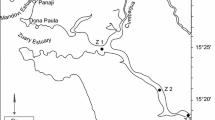Summary
Sedimentation of phytoplankton provides food and energy for zoobenthic communities. In this study the rates, species composition and biomass of phytoplankton input to Frobisher Bay sediments were examined during ice (late November to July) and open water (late July to October) periods from 1982 to 1985. The rates were higher on the sea bed than at 20 m. The minimum rate (3x105 cells·m-2·day-1) of sedimentation occurred during the early part of the ice period. It increased as the ice thickened and reached a maximum of 2.8x108 cells·m-2·day-1 after the phytoplankton bloom at the beginning of the open water period in the first two weeks of August. The sedimented phytoplankton was dominated by diatoms, with a great majority of pennate species during the spring (April to June) and centric forms during the summer (July to August). Green flagellates, dinoflagellates and chrysophytes occurred as a low percentage of the total population in all seasons. Other indicators (chlorophyll a and phaeopigments) showed highest biomass levels in the deepest traps. They were consistently low during the winter (December to March) and reached their maxima during the open-water period of summer. Their abundance was correlated with the seasonal cycle of the phytoplankton in the water column.
Similar content being viewed by others
References
Atkinson EG, Wacasey JW (1987) Sedimentation in Arctic Canada: particulate organic carbon flux to a shallow marine benthic community in Frobisher Bay. Polar Biol (in press)
Bienfang PK, Harrison PJ, Quarmby LM (1982) Sinking rate response to depletion of nitrate, phosphate and silicate in four marine diatoms. Mar Biol 67:295–302
Davies JM, Payne R (1984) Supply of organic matter to the sediment in northern North Sea during a spring phytoplankton bloom. Mar Biol 78:315–324
Dunbar MJ (1958) Physical oceanographic results of the “Calanus” expeditions in Ungava Bay, Frobisher Bay, Cumberland Sound, Hudson Strait and northern Hudson Bay, 1954–1955. J Fish Res Board Can 15:155–201
Fenchel T (1978) The ecology of micro- and meiobenthos. Annu Rev Ecol Syst 9:99–121
Gardner WD (1985) The effect of tilt on sediment trap efficiency. Deep-Sea Res 32:349–361
Grainger EH (1975) A marine ecology study in Frobisher Bay, Arctic Canada. In: Cameron TWM, Billingsley LW (eds) Energy flow — its biological dimensions: a summary of the IBP in Canada 1964–1974. R Soc Can, pp 261–266
Hargrave BT, Taguchi S (1978) Origin of deposited material sedimented in a marine bay. J Fish Res Board Can 35:1604–1613
Hargrave BT (1980) Factors affecting the flux of organic matter to sediments in a marine bay. In: Tenore KR, Coull BC (eds) Marine benthic dynamics. University of South Carolina Press, pp 243–263
Hargraves PE, French FW (1983) Diatom resting spores: significance and strategies. In: Fryxell GA (ed) Survival strategies of the algae. Cambridge University Press, New York, pp 49–68
Horner RA (1985) Ecology of sea ice microalgae. In: Horner RA (ed) Sea ice biota. CRC Press, pp 83–103
Hsiao SIC (1979) Phytoplankton data and sea ice microalgal data from Frobisher Bay, 1971 to 1978. Fisheries and Environment Canada, Fish Mar Ser Data Rep 155:82 pp
Hsiao SIC (1980) Quantitative composition, distribution, community structure and standing stock of sea ice microalgae in the Canadian Arctic. Arctic 33:768–793
Hsiao SIC, Pinkewycz N (1985) Arctic marine phytoplankton contributed to the sediments in Frobisher Bay. Can Data Rep Fish Aquat Sci 539:106 pp
Jeffrey SW, Humphrey GF (1975) New spectrophotometric equations for determining chlorophyll a, b, c, c1 and c2 in higher plants, algae and natural phytoplankton. Biochem Physiol Pflanz 167:191–194
Lovrity JE (1984) Oceanographic data from Frobisher Bay in the eastern Canadian Arctic for years 1982 and 1983. Can Data Rep Fish Aquat Sci 432:57 pp
Mills EL (1975) Benthic organisms and structure of marine ecosystems. J Fish Res Board Can 32:1657–1663
Smayda TJ (1970) The suspension and sinking of phytoplankton in the sea. Oceanogr. Mar Biol Annu Rev 8:353–414
Smetacek V, Brockel Kvon, Zeitzschel B, Zenk W (1978) Sedimentation of particulate matter during a phytoplankton spring bloom in relation to the hydrographic regime. Mar Biol 47:211–226
Smetacek V (1980) Annual cycle of sedimentation in relation to phytoplankton ecology in western Kiel Bight. Ophelia (Suppl) 1:65–76
Smetacek V (1985) Role of sinking in diatoms life-history cycles: ecological, evolutionary and ecological significance. Mar Biol 84:239–251
Stephens K, Sheldon RW, Parsons TR (1967) Seasonal variations in the available of food for benthos in a coastal environment. Ecology 48:852–855
Strickland JDH, Parsons TR (1972) A practical handbook of seawater analysis. Fish Res Board Can Bull 167:310 pp
Wassmann P (1985) Sedimentation of particulate material in Nord-asvannet, a hypertrophic, land-locked fjord in western Norway. Mar Ecol Prog Ser 22:259–271
Author information
Authors and Affiliations
Rights and permissions
About this article
Cite this article
Hsiao, S.I.C. Sedimentation in Arctic Canada: Species composition and biomass of phytoplankton contributed to the marine sediments in Frobisher Bay. Polar Biol 7, 245–251 (1987). https://doi.org/10.1007/BF00287421
Received:
Accepted:
Issue Date:
DOI: https://doi.org/10.1007/BF00287421




